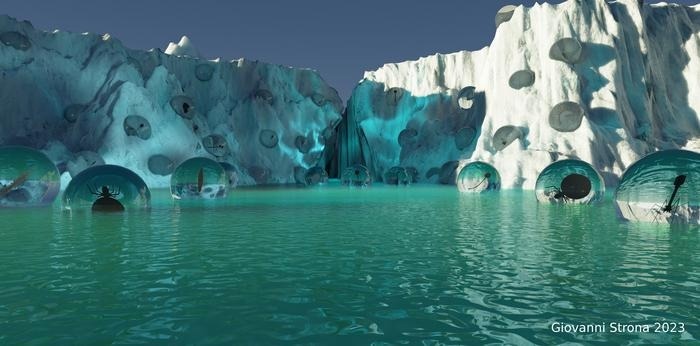Climate change may expedite the release of “time-traveling” pathogens trapped in melting permafrost and ice for millennia. Their emergence raises the stakes for the global environment and even humanity.

Image Credit: Giovanni Strona, 2023
While melting glaciers and permafrost threatens the re-emergence of many types of dormant pathogens, the potential damage to advanced ecosystems presented by these microbes has been difficult to anticipate.
However, a new global study published in the open-access journal PLOS Computational Biology by Dr. Giovanni Strona of the European Commission Joint Research Centre and Corey Bradshaw, Matthew Flinders Professor of Global Ecology from Flinders University in Australia, has assessed the ecological threats posed by the release of these unpredictable ancient microbes.
The researchers created simulations in which digital pathogens from the past infiltrate communities of bacteria-like hosts. They compared the effects of invading pathogens on host bacterial diversity to those in communities where no invasions occurred.
In their simulations, the scientists discovered that the ancient invading pathogens could often survive and evolve in the modern world, with about 3% becoming dominant in their new environment.
About 1% of those invaders produced unexpected results, with some causing up to one-third of the host species to become extinct, while others increased diversity by up to 12% when compared to simulations where escape was not permitted.
Although the risks posed by this 1% of released pathogens may appear negligible, the researchers claim that these outbreaks pose a significant threat given the sheer volume of ancient microbes routinely released into modern communities.
The scientific debate on the topic has been dominated by speculation, due to the challenges in collecting data or designing experiments to elaborate and test hypotheses. For the first time, we provide an extensive analysis of the risk posed to modern ecological communities by these ‘time-traveling’ pathogens through advanced computer simulations.
Dr. Giovanni Strona, Study Lead Author, European Commission Joint Research Centre
Dr. Giovanni Strona adds, “We found that invading pathogens could often survive, evolve and, in a few cases, become exceptionally persistent and dominant in the community, causing either substantial losses or changes in the number of living species. Our findings, therefore, suggest that unpredictable threats so far confined to science fiction could in reality pose serious risk as powerful drivers of ecological damage.”
According to Professor Corey Bradshaw of Flinders University, the latest research indicates a real threat from unknown “black swan” pathogens that can inflict irreparable harm.
From that perspective, our results are worrisome, because they point to an actual risk deriving from the rare events where pathogens currently trapped in the permafrost and ice produce severe ecological impacts. In the worst, but still entirely plausible case, the invasion of a single ancient pathogen reduced the size of its host community by 30% when compared to our non-invasive controls.
Corey Bradshaw, Professor, Flinders University
Corey Bradshaw notes, “As a society, we need to understand the potential risk posed by these ancient microbes so we can prepare for any unintended consequences of their release into the modern world. The results tell us that the risk is no longer simply a fantasy that we shouldn’t be prepared to defend against.”
The investigators built and tested the simulated release of the digital pathogens into biological communities using Avida, an artificial-life software platform created by Michigan State University.
Ancient pathogens emerging from melting ice and permafrost risk eroding ecosystems
Video Credit: Flinders University
Journal Reference:
Strona, G., et al. (2023) Time-travelling pathogens and their risk to ecological communities. PLOS Computational Biology. doi.org/10.1371/journal.pcbi.1011268.